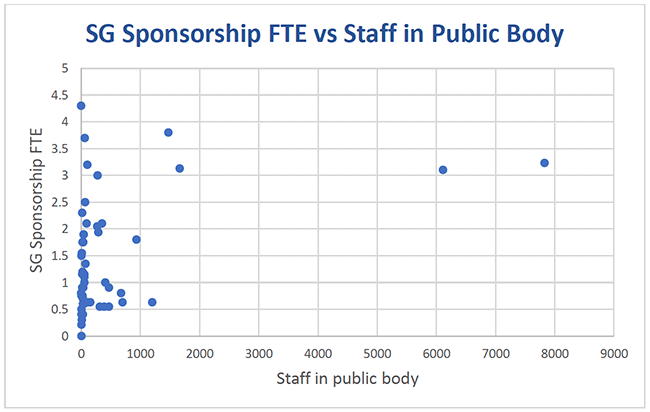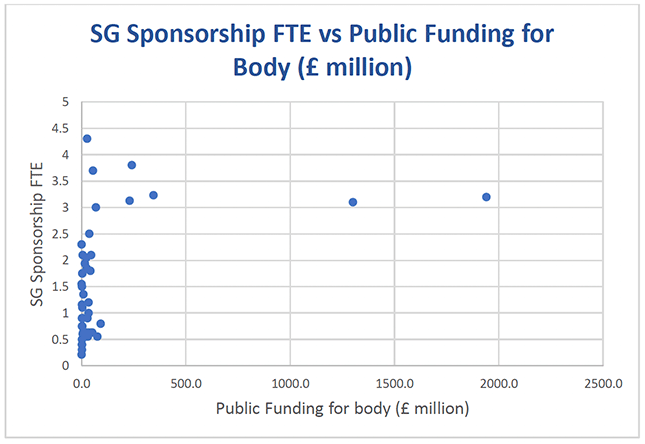Scottish Government relationships with public bodies: progress review
This report, conducted by Glen Shuraig Consulting, contains 14 recommendations for improving how the Scottish Government manages its relationships with public bodies. The recommendations look to strengthen existing policies, address concerns, and allow for consistently effective sponsorship.
1 The case for change
1.1 The work done on this review shows that the vast majority of relationships between Scottish Government (SG) and the public bodies considered are functioning effectively on a day-to-day basis. Where issues arise, the personal relationships between senior managers in public bodies and their SG contacts are sufficiently good that in most cases a workable solution can be found. Public bodies themselves identified Covid recovery, Climate Change, the financial outlook and workforce challenges as, in most cases, more pressing concerns for their business than their relationship with SG. If that is the overall position, why should SG prioritise action to improve the way that it manages its relationships with public bodies?
1.2 There are four broad reasons, and they relate also to the values established in Scottish Government's Vision. The first and most important reason is ensuring that SG's management of its relationship with public bodies supports them in achieving the best possible outcomes and achieving public value for people, places and communities across Scotland. The public bodies considered in this report are between them responsible for more than £19.5 billion[2] of public money. Between them, they employ tens of thousands of staff. The services provided by public bodies have to meet the needs of the people of Scotland as set out in the Government's priorities. Although public bodies are well aware of the National Performance Framework (NPF) outcomes and the drive for Public Service Reform (PSR), the evidence from interviews suggests that there is still some way to go in establishing arrangements for managing relationships with public bodies that are fully aligned to NPF and PSR priorities. Public bodies cannot achieve the best outcomes and the most effective collaboration if their lines of accountability are not clear or if different aspects of accountability are pulling them in different directions. Addressing accountabilities and ensuring good alignment will allow SG to work more effectively with public bodies, in line with its stated value of collaboration.
1.3 A second reason for change is ensuring that the arrangements for managing relationships with public bodies are robust enough to cope effectively with the more challenging risks and issues that arise. One of the drivers for the commissioning of this review was criticism from Audit Scotland and the former Scottish Parliament Public Audit and Post-Legislative Scrutiny Committee[3] of SG's management of its relationships with a range of public bodies which had problems with either corporate or programme governance picked up in reports under section 22 of the Public Finance and Accountability (Scotland) Act 2000 (the PFA Act). Some problems and failures in public bodies are inevitable, particularly in an overall drive for innovation and improvement, so the challenge is how to avoid as many of these as possible turning into serious problems and how to deal effectively and fairly with the more serious situations. Director-Generals (DGs) as Portfolio Accountable Officers need to be able to have confidence that the assurance arrangements in place with public bodies will support them to fulfil their Accountable Officer duties and to make appropriate judgements, and to have confidence that the £19.5 billion of public money is being managed well. Evidence in this review suggests that managing assurance arrangements with public bodies more systematically than SG does at present will provide better support to DGs on this critical area of responsibility. This would be in line with SG's value to act with integrity and reflect the values of the Civil Service. It is also highly relevant to the criticism in the legacy report of the Public Audit and Post-Legislative Scrutiny Committee that 'it is simply unacceptable that there continue to be examples of weak and inconsistent challenge being provided by Scottish Government officials and of problems not being identified or acted upon until it is too late'.
1.4 There is a significant challenge around capability. Based on a trawl carried out by the Public Bodies Unit in September 2021, with some gaps in returns, there are more around 200 staff in bands A to C across SG involved in the management of relationships with public bodies (excluding the Territorial and National Health Boards). Levels of churn mean that many staff involved are inexperienced in sponsorship work and/or are still working to establish their relationship with the public body. Directors and Deputy Directors with public body responsibilities are also investing a significant amount of time in those relationships and in some cases may also be relatively inexperienced, either in the role or in relation to the particular public body or bodies. The importance of the sponsorship role and the skills required to do it well are not always recognised. At a minimum, there needs to be good training and support available to all of the staff undertaking this work to ensure that there is a good return on the money SG is spending on managing relationships with public bodies. This would be in line with the vision for SG as an organisation that learns and improves.
1.5 Finally, there is an efficiency argument for change. The time that the 200 staff are spending on sponsorship work is estimated to add up to the equivalent of almost 100 full-time posts, with more than 33 full-time equivalents at C band. This will be an underestimate, as it does not take account of senior civil service time, nor of time spent working with agencies and other bodies which are not formally 'sponsored'. It may not seem high compared to overall SG staffing, but it is significant, particularly at a time when SG faces many pressures. There are substantial variations in levels of staffing in sponsorship activity for different bodies. It is interesting to note that there is no obvious correlation between the SG full-time equivalent staffing devoted to sponsorship and the overall staff numbers of the public body, nor is there an obvious correlation with the amount of public money for which the body is responsible (see Figure 1 and Figure 2 below).


1.6 There can be many drivers of the amount of sponsorship activity for SG, including the level of political interest and the recent history of the public body, and the number of staff or the level of public funding for the body are very crude measures that will not properly capture its overall importance to Scottish Ministers. The figures still raise some interesting questions, however. It appears that there might be value in checking that the staff effort devoted to sponsorship work remains appropriate for each public body, as well as ensuring that all have the right capability as highlighted above.
1.7 If the case for change is accepted, there will have to be some investment initially to make change. This report contains a number of recommendations that will take time and effort to implement. The Public Bodies Unit will need some additional people to carry out work on building overall sponsorship capability and resilience across SG. There is additional work proposed for DG and Director business management teams to ensure that assurance arrangements are robust that may also require additional capacity. Many sponsor teams will have to change aspects of how they currently operate. All of this would require a coordinated and sustained effort across SG at a time when staff at all levels are under considerable Covid, Brexit and other pressures. It is important to be realistic about what is achievable under the current circumstances. Ideally, SG would establish a change programme to implement all of the accepted recommendations, but that will only be able to deliver successfully if it is possible to commit the resources and senior attention required. It would be better to be clear at the start what resource can realistically be committed to change and then to decide how to prioritise that. This report describes the current position, sets out recommendations and offers thoughts on those priorities for change.
Contact
There is a problem
Thanks for your feedback